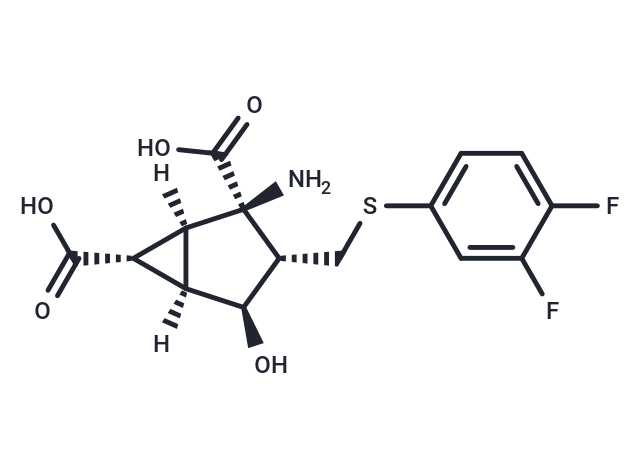Shopping Cart
Remove All Your shopping cart is currently empty
Your shopping cart is currently empty
LY3020371 is a highly potent and selective antagonist targeting the glutamate (mGlu) 2/3 receptor, showcasing excellent inhibition at Ki values of 5.26 nM and 2.50 nM for hmGluR2 and hmGluR3, respectively. With its remarkable affinity and specificity, LY3020371 serves as a valuable tool in depression research.

| Pack Size | Price | USA Warehouse | Global Warehouse | Quantity |
|---|---|---|---|---|
| 5 mg | Inquiry | Inquiry | Inquiry |
| Description | LY3020371 is a highly potent and selective antagonist targeting the glutamate (mGlu) 2/3 receptor, showcasing excellent inhibition at Ki values of 5.26 nM and 2.50 nM for hmGluR2 and hmGluR3, respectively. With its remarkable affinity and specificity, LY3020371 serves as a valuable tool in depression research. |
| Targets&IC50 | mGluR2 (human):5.26 nM (Ki), mGluR3 (human):2.50 nM (Ki) |
| In vitro | LY3020371, across a range of 0.1 nM to 100 μM, competitively inhibits the binding of the mGlu2/3 agonist ligand [3 H]-459477 with significant affinity[1]. At the same concentration range, it prevents DCG-IV from inhibiting forskolin-induced cAMP production in cells with recombinant human mGlu2 (IC50=16.2 nM) and mGlu3 (IC50=6.21 nM) receptors[1]. Additionally, LY3020371 demonstrates concentration-dependent antagonism towards LY379268-induced inhibition of cAMP formation across a span of 0.3-30,000 nM[1]. Furthermore, between 1-10,000 nM, it effectively counteracts the suppression of K+-induced glutamate release caused by LY379268, with an optimal effectiveness (IC50) at 86 nM[1]. In a similar concentration range (0.3-10,000 nM), it fully blocks the LY379268-induced suppression response, achieving an IC50 value of 33.9 nM[1]. |
| In vivo | LY3020371, administered intravenously (i.v.) at doses ranging from 0.3 to 3 mg/kg, significantly increases the number of spontaneously active dopamine neurons in the ventral tegmental area (VTA) of rats. When given intraperitoneally (i.p.) at 1 to 10 mg/kg once a week for five weeks, it dose-dependently enhances tissue oxygen levels in the anterior cingulate cortex (ACC) of rats. A single i.p. dose of 10 mg/kg leads to an increase in monoamine efflux in the medial prefrontal cortex of freely moving rats. Moreover, a single i.v. administration of LY3020371 in doses ranging from 1 to 30 mg/kg elevates the cumulative wake time in rats in both a dose- and time-dependent manner, without causing rebound hypersomnolence. Additionally, doses from 0.1 to 10 mg/kg administered i.v. reduce the duration of immobility in the forced-swim test, indicating potential antidepressant activity. In a specific set-up using male Sprague-Dawley rats weighing between 230–350 g, dosages of 0.3, 1, and 3 mg/kg were administered via i.v. daily for five days per week over two weeks, resulting in an increased count of actively firing dopamine neurons in the VTA of anesthetized subjects. |
| Molecular Weight | 359.34 |
| Formula | C15H15F2NO5S |
| Cas No. | 1377615-75-2 |
| Smiles | [H][C@]12[C@H](C(O)=O)[C@@]1([H])[C@@](N)([C@H](CSc1ccc(F)c(F)c1)[C@H]2O)C(O)=O |
| Storage | Powder: -20°C for 3 years | In solvent: -80°C for 1 year | Shipping with blue ice/Shipping at ambient temperature. |
| Size | Quantity | Unit Price | Amount | Operation |
|---|

Copyright © 2015-2026 TargetMol Chemicals Inc. All Rights Reserved.